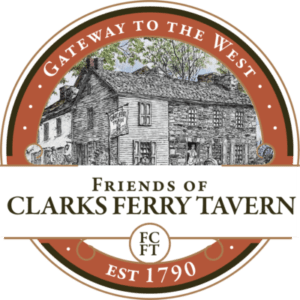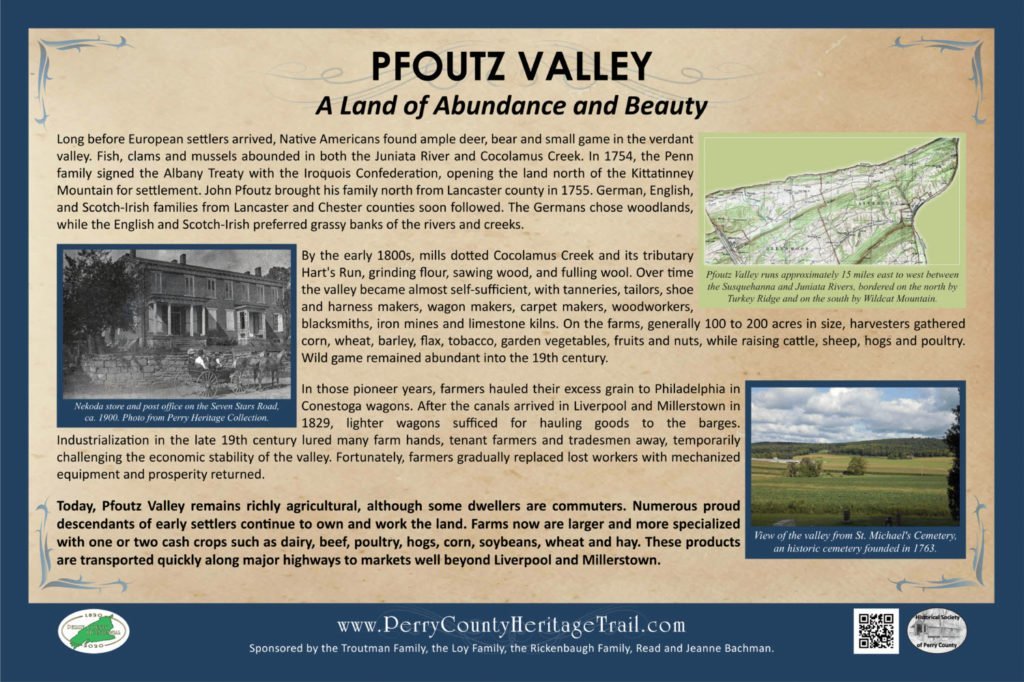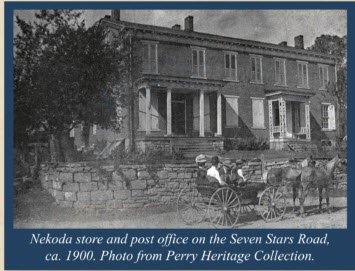PFOUTZ VALLEY
A Land of Abundance and Beauty

Pfoutz valley runs approximately 15 miles east to west between the Susquehanna and Juniata Rivers, bordered on the north by Turkey Ridge and on the south by Wildcat Mountain. (NOTE: The map is not complete. Cindy will insert correct map.)
Long before European settlers arrived, Native Americans found abundant deer, bear and small game in the valley. Fish, clams and mussels were abundant in both the Juniata River and Cocolamus Creek. In 1754, the Penn family signed the Albany Treaty with the Iroquois Confederation, opening the land north of the Kittatinney Mountain for settlement. John Pfoutz brought his family north from Lancaster county in 1755. German, English, and Scotch-Irish families from Lancaster and Chester counties soon followed. The Germans chose the woodlands, while the English and Scotch-Irish preferred the grassy banks of the rivers and creeks.
View of the valley from St. Michael’s Cemetery, an historic cemetery founded in 1763.
Mills dotted Cocolamus Creek and its tributary Hart’s Run by 1800, grinding flour, sawing wood, and fulling and weaving cloth. With tanneries, tailors, shoe and harness makers, wagon makers, carpet makers, wood workers, blacksmiths, iron mines and limestone kilns, the valley was largely self-sustaining. Farms, generally 100 to 200 acres, were productive and diversified. Farmers harvested corn, wheat, barley, flax, tobacco, garden vegetables, fruits and nuts while raising cattle, sheep, hogs and poultry. Wild game remained abundant.
Nekoda store and post office on the Seven Stars Road, ca. 1900.
In those early years, farmers hauled their excess grain to Philadelphia in Conestoga wagons. After the canals arrived in Liverpool and Millerstown in 1829, lighter wagons sufficed for hauling goods to market. Industrialization in the late 19th century lured many farm hands, tenant farmers and tradesmen away, temporarily challenging the economic stability of the valley. Gradually farmers replaced lost workers with mechanized equipment and prosperity returned.
Today, Pfoutz valley remains richly agricultural, although many dwellers are commuters. Numerous proud descendants of early settlers continue to own and work the land. Farms are larger and more specialized with one or two cash crops such as dairy, beef, poultry, hogs, corn, soybeans, wheat and hay. They are transported quickly along major highways to markets well beyond Liverpool and Millerstown.
Sources: Forty Letters to Carson Long; Tales of the Cocolamus; and Émigré Saga by Theodore Long; Perry County Grist Mills; by Eugene Eby. Also Lorraine Troutman and Jean Tuzinski. Research by Jane Hoover.



